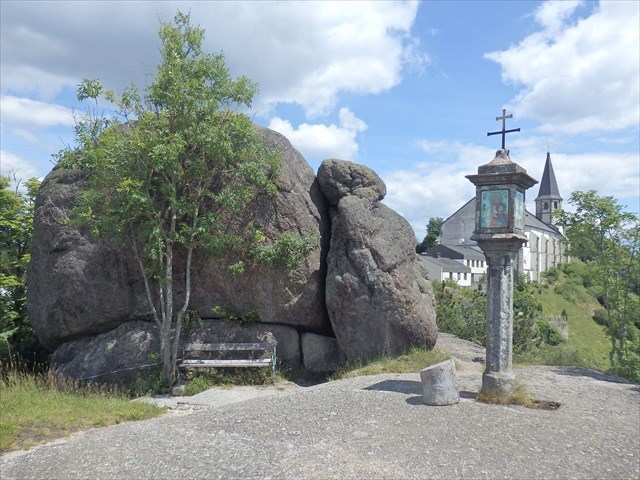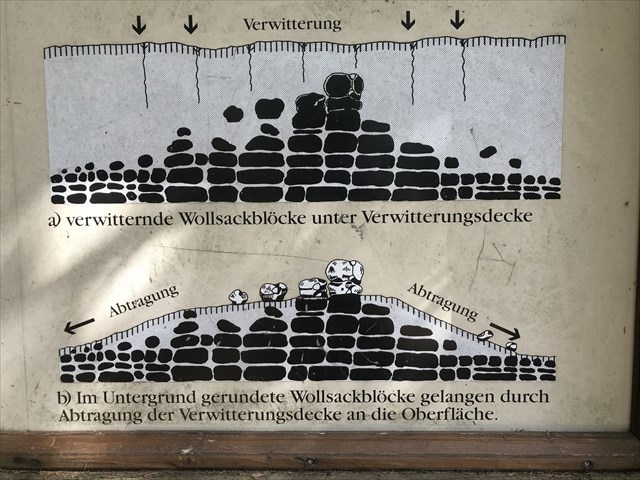Bucklwehluckn


Die sogenannte "Bucklwehluckn" in St. Thomas am Blasenstein ist eine auffällige, einzigartige Felsformation aus Weinsberger Granit. In der durch Wollsackverwitterung geformten Felsformation befindet sich ein Spalt, durch den man - entsprechende körperliche Fitness vorausgesetzt - durchkriechen kann. Es wird behauptet, dass ein Durchzwängen durch die Lücke von Rückenschmerzen befreien soll - ältere Mythen behaupten auch, junge Frauen, die durch die Lücke durchkommen, würden später im Leben einen "braven Mann" bekommen. Wie auch immer, ein Besuch des Platzes lohnt auf jeden Fall, er hat ein eigenes Flair und auch die Aussicht ist großartig.
Weinsberger Granit
Weinsberger Granit ist ein im Mühlviertel und Waldviertel verbreiteter, vom Aussehen her sehr grobkörniger Granit. Er ist Teil des Südböhmischen Plutons, eines aufgestiegenen Magmakörpers, der mit rund 6000 Quadratkilometern Ausdehnung auf der Erdoberfläche zu den größten Intrusionskörpern der Variszischen Orogenese (Gebirgsbildung) gehört. Entstanden ist der Weinsberger Granit vor fast einer halben Milliarde Jahren, er ist somit eine der ältesten Gesteinsarten der Erde. Auffällig sind im Weinsberger Granit die außergewöhnlich großen Feldspatkristalle (Plagioklaskristalle), sie zeigen, dass das Magma sehr langsam erstarrt ist. So konnten sich dermaßen große Kristalle bilden.
Das Verbreitungsgebiet des Weinsberger Granits liegt im westlichen Waldviertel von der Donau bis knapp nördlich von Gmünd sowie im östlichen, unteren Mühlviertel bis Mauthausen. Dieses Gebiet ist weitaus größer als jenes des namensgebenden Weinsberger Waldes, ein paar Ausläufer lassen sich bis Bayern verfolgen.
Der Weinsberger Granit ist ein außergewöhnlich grobkörniger Granit mit grob- bis riesentafeligen Kalifeldspaten. Das Gestein ist ursprünglich grau, verfärbt sich allerdings im Zuge der Verwitterung braun bis rotbraun. Dabei lassen sich die Kalifeldspate recht leicht aus dem Granit lösen, was zu Wollsackverwitterung führt. Mit seiner starken Verwitterung (Vergrusung), bei der Granit letztlich zu Sand zerfällt, trägt das Gestein wesentlich zum Landschaftsbild des westlichen Waldviertels und Mühlviertels bei.
Wollsackverwitterung
Die Wollsackverwitterung ist eine weltweit beobachtbare Verwitterungserscheinung bei grobkristallinen, massigen Gesteinen wie Granit. Die "Wollsäcke" - vereinzelt oder übereinander geschichtet - bilden oft weitgehend vegetationslose Felsburgen. Ursache der Wollsackverwitterung sind an oder nahe an der Erdoberfläche verlaufende Verwitterungsprozesse. Eine wichtige Voraussetzung ist das Vorhandensein eines Netzes aus mehr oder weniger rechtwinklig zueinander erodierten Trennflächen, die das Gestein in Blöcke gliedern. An Schichtkontakten und Klüften können chemisch aggressive Lösungen (mit Huminsäuren angereichertes Wasser) in das Gestein eindringen und beginnen, Minerale zu zersetzen. Das dabei entstehende feinkörnige Lockermaterial wird als Grus bezeichnet. Mit fortschreitender Verwitterung bilden sich die typisch rundlichen Formen aus. Im fortgeschrittenen Stadium können sich durch Wollsackverwitterung Wackelsteine ausbilden.

Die sogenannten Wollsäcke, gerundete, kissenartige Blöcke, bildeten sich im Mühl- und Waldviertel unter tropischen Klimaverhältnissen vor etwa 1,5 Millionen Jahren, noch vor den Eiszeiten. Durch das Vordringen der chemischen Verwitterung entlang von Kluftsystemen wurden die Gesteinsquader allseitig angegriffen, verkleinert und vor allem an den Kanten abgerundet. Im Laufe der Zeit wurde das die Felsblöcke bedeckende Material abgetragen und die Wollsäcke kamen an die Oberfläche.

The "Bucklwehluckn"
The so-called "Bucklwehluckn" in St. Thomas am Blasenstein (Mühlviertel, Upper Austria) is a striking, unique rock formation made of Weinsberg granite. In the rock formation formed by wool sack weathering, there is a gap through which you can crawl - provided you are physically fit. It is claimed that squeezing through the the gap is supposed to relieve back pain - older myths also claim that young women who get through the gap will get a "good husband" later in life. However, the location is definitely worth a visit, it has its own flair and the view is amazing.
Weinsberg Granite
Weinsberg granite is a very coarse-grained granite that is widespread in the Mühlviertel and Waldviertel. It is part of the South Bohemian Pluton, an ascended magma mass, which, with an area of around 6000 square kilometers on the earth's surface, is one of the largest masses of intrusive rock of the Variscan orogeny (mountain building). The Weinsberg granite was created almost half a billion years ago, making it one of the oldest rock types on earth. The unusually large feldspar crystals (plagioclase crystals) in the Weinsberg granite are noticeable; they show that the magma has solidified very slowly. So such large crystals could form.
The distribution area of the Weinsberg granite is in the western Waldviertel from the Danube to just north of Gmünd and in the eastern, lower Mühlviertel to Mauthausen. This area is much larger than that of the eponymous Weinsberg forest, a few foothills can be traced as far as Bavaria.
The Weinsberg granite is an exceptionally coarse-grained granite with coarse to giant tabular potash feldspars. The rock is originally gray, but changes colour from brown to red-brown as the weathering progresses.The potash feldspars can be removed from the granite quite easily, which leads to wool sack weathering. Due to the strong weathering process, during which granite ultimately breaks down into sand, the rock contributes significantly to the landscape of the western Waldviertel and Mühlviertel.
Wool Sack Weathering
The wool sack weathering is a weathering phenomenon that can be observed worldwide in coarse crystalline, massive rocks such as granite. The "wool sacks" - singly or stacked on top of each other - often form rock castles that are largely free of vegetation. The cause of wool sack weathering are weathering processes on or near the surface of the earth. An important prerequisite is the existence of a network of more or less eroded dividing surfaces that divide the rock into blocks. At layer contacts and fissures, chemically aggressive solutions (water enriched with humic acids) can penetrate the rock and begin to decompose minerals. The resulting fine-grained loose material is known as grite. As the weathering processes, the typical rounded shapes develop. In the advanced stage, rocking stones can form due to wool sack weathering.
The so-called wool sacks, rounded, pillow-like blocks, have been formed in the Mühlviertel and Waldviertel under tropical climatic conditions about 1,5 million years ago, before the ice ages. Due to the penetration of chemical weathering along crevice systems, the stone blocks were attacked on all sides, reduced in size and, above all, rounded at the edges. Over time, the material covering the boulders was removed and the wool sacks came to the surface.
Um den Earthcache zu loggen, beantworte bitte folgende Fragen via Message (nicht Mail!):
1.) Betrachte den Felsen vor Ort (Weinsberger Granit) und beschreibe die Struktur, Farbe und Oberfläche des Gesteins!
2.) Betrachte speziell die auffällig großen Feldspatkristalle im Granit - wie groß sind die größten Kristalle, die du beobachten kannst?
3.) Betrachte nun die "Bucklwehluckn", die durch Wollsackverwitterung entstandene Kluft im Fels - beschreibe die Ausmaße der Kluft!
4.) Welches Hindernis findest du in der "Bucklwehluckn", das ein Durchkriechen so schwierig macht?
Optional kannst du gerne ein Foto von dir oder deinem GPS bei den Koordinaten mit dem Log hochladen!
Bitte in den Logs keinerlei Informationen zu den Fragen geben!
Sobald du die Message abgeschickt hast, kannst du loggen, eine Logerlaubnis ist nicht notwendig! Sollte etwas nicht passen, melde ich mich!
To log this Earthcache, please send me the answers on the following questions via message (not mail!):
1.) Take a closer look at the rock (Weinsberger granite) and describe the structure, surface and colour of the rock!
2.) In particular, look at the strikingly large feldspar crystals in the granite - how big are the largest crystals you can observe?
3.) Now look at the "Bucklwehluckn", the rift in the rock caused by wool sack weathering - describe the dimensions of the rift!
4.) What obstacle do you find in the "Bucklwehluckn (the rift in the rock) that makes crawling through so difficult?
Please, don't give any informations in your logs!
Optional you can post a picture of yourself or your GPS unit near the location, if you like!
There is no need to wait for a log permission! You can log the cache as a found after you sent me the answers - if there's something wrong, I'll contact you!
Have fun and enjoy the location! Silberschakal
Quellen/sources:
Fuchs, G. & A. Matura: Zur Geologie des Kristallins der südlichen böhmischen Masse. In: Jahrbuch der Geologischen Bundesanstalt, Band 119, S. 15 - 17. Wien 1976.
Murawski, H.: Geologisches Wörterbuch. Stuttgart 1992 (9).
www.de.wikipedia.org
www.harzlife.de
Fotos/pictures:
Autor/author